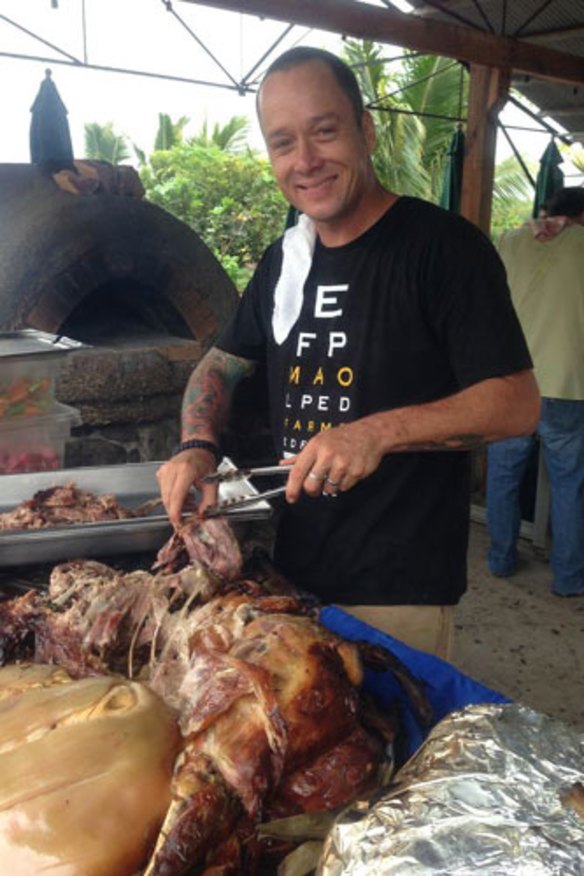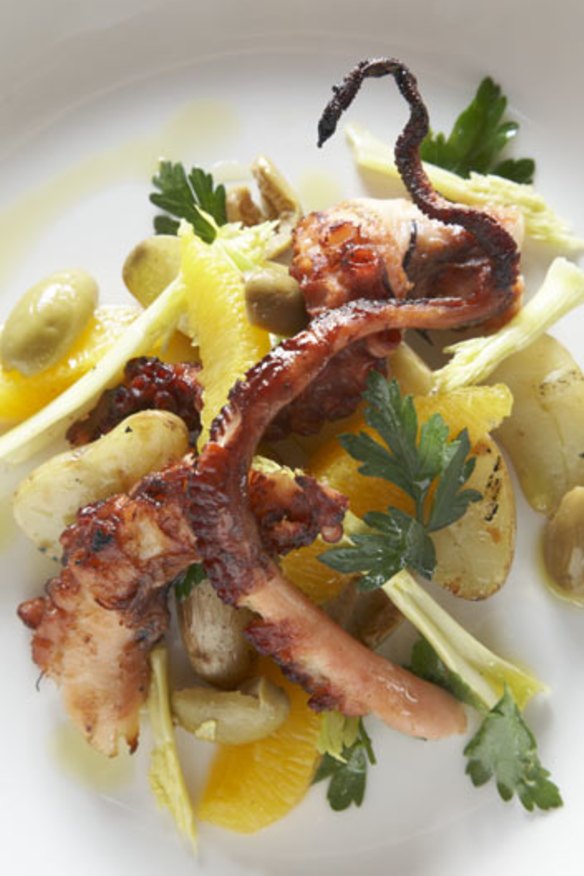Hawaiian local-food hero heads our way

Thanks to local drawcard Ben Shewry, Hawaiian chef Ed Kenney will turn hundreds of years of cultural history on its head at this year's Melbourne Food and Wine Festival.
The imu, an underground steam oven utilising volcanic rocks and banana leaves, has been used by Hawaiians for centuries to cook whole pigs during times of celebration.
But for the past six months, ahead of his trip to Australia, Kenney has been forced to experiment with lamb in the imu instead. Shewry, from Melbourne's Attica restaurant, got first dibs on pork.

The two chefs will go head to head as part of the day-night Earth Masterclass at the CERES environment park. Food festival organisers no doubt considered those splashing out $450 for a ticket may not have fancied pork cooked two ways, so Shewry will cook pork shoulder in a hangi – the New Zealand version of the underground or pit oven.
Rather than being fazed, Kenney jumped at the chance to challenge Hawaiian tradition. "Surfboards were invented in Hawaii and they were big wooden planks, and now they're made out of carbon fibre and space-age material," he says over the phone.
"But the imu is virtually unchanged from the way it was used hundreds of years ago. I've been wondering about this for years, so when I was approached by the Melbourne folk it gave me a reason to experiment."
He's not only been experimenting with lamb, but chicken in cast iron pots sealed with dough. The verdict? "Amazing."
Kenney is not afraid of a challenge. In Hawaii he is known as a hero of the local food movement. This may not sound like a big deal in Australia - a net agricultural exporter - but in Hawaii, locally produced food really is the exception.
Located in the middle of the North Pacific Ocean, about 4000 kilometres west of mainland America, Hawaii has become reliant on imports for roughly 90 per cent of its food supply. It's an oft-quoted line that if imports were suddenly halted, Hawaii's 1.3 million residents would run out of food in a week.
Hawaii's reliance on food produced elsewhere did not happen overnight, Kenney says; it has been about 250 years in the making. And it's not a growing population that has turned Hawaii from a state of complete self-sufficiency in this time, but rather, changing tastes. Waves of immigration have seen the native Hawaiian cuisine evolve from a diet based largely on fish and local fruit and vegetables to a far more complex cuisine with influences ranging from Portuguese to Chinese to Filipino to Japanese.
But growing demand for pork, chicken, non-local fish species such as tuna and, more latterly, ingredients influenced by the mainland US (such as dairy and wheat) has not translated to local production.
Kenney says there is now just one dairy on Oahu, by far the most populous of Hawaii's islands. The dairy produces only cheese, so nearly all of Hawaii's milk is shipped from California. Likewise, Oahu has just one small chicken farm, "a mom and pop operation" that mainly produces eggs and only sells chickens at a small local farmers' market.
The reasons are many, but one of the most significant is the high price of agricultural land in Hawaii, which has seen it concentrated in the hands of a few.
Kenney says a large chunk of Hawaii's agricultural land is now dedicated to growing genetically modified seeds and crops, which are then shipped back to the mainland.
"There's very limited water and land is extremely expensive. Agricultural land is going for $US100,000 an acre in some places and I think most farmers would laugh at spending that much for an acre to grow vegetables off."
Nevertheless, Kenney is optimistic things can change. The former real estate agent has helped spearhead a push towards local food production over the past decade that is slowly gaining traction. His eight-year-old restaurant, Town, located on a nondescript, busy street corner in Kaimuki, south-west of Honolulu, managed to source almost half of its food from Hawaiian producers in 2011 (an internal audit put it at 46.4 per cent).
It's a particularly impressive figure given Town's menu is rooted in Italian cuisine.
"We grow no wheat or rice here and we serve risotto and a lot of pasta and bread ... We had a chicken dish and sourced all the chicken locally but then the farm folded three years after we opened and we had to start sourcing organic chickens from California."
The "mom and pop" operation does not produce enough for Town (which attracts hundreds of diners each week), let alone Oahu as a whole.
However, growing demand for local produce from chefs such as Kenney has encouraged new small-scale ventures, and some larger land-holders are beginning to sub-let for small farming lots. Kenney does more than buy local produce, he sits on the board of MA'O Organic Farm, a not-for profit that employs disadvantaged young native Hawaiians and gives them a college degree in sustainable agriculture.
Kenney is also on the Board of the Kokua Hawaii Foundation, an initiative started by his friend, the musician Jack Johnson. Kokua runs environmental awareness programs in primary schools in Hawaii and Kenney has a hands-on role in helping students establish vegetable gardens. The gardens are then used in the school's curriculum.
"The kids might go out and measure how much a sunflower grows over three days as part of science," Kenney explains.
MA'O farm is just 13 years old but has grown to produce more than 30 fruit and vegetable lines. US first lady Michelle Obama is a fan and has spruiked the farm as a model for other parts of the country.
Kenney began a relationship with the farm founders buying their products a decade ago and now has a leadership role on the board and on the ground.
He is hopeful that more farms (and farming know-how) will help him realise his ultimate goal: to run a restaurant that only serves Hawaiian-produced ingredients.
"There's so much that we have available now that we didn't even have when Town started up," he says. "Recently we got some kohlrabi and fresh tumeric in. We've started to see heirloom beans.
"There was always only one variety of taro [available], and there are supposedly more than 250 varieties, so we're sourcing more and more varieties that all have distinct characteristics.
"Limu is a local seaweed but ... native varieties have been smothered by invasive species that we have been eating, but which weren't traditional. So we're seeing some of the native species coming back. They're farming it on land in tanks. There's a new chicken farm going to be starting up in the next two or three months ..."
Kenney recently put rabbit on the menu for the first time after a local pig farmer decided to branch out.
"We bought half a dozen [rabbits] and it sold out within two nights."
He's also a champion of native Hawaiian cuisine, giving taro and limu a modern-day spin on his menu.
One example is Kenney's treatment of pa'i 'ai (traditional hand-pounded taro). "It's often equated to wallpaper paste," he says, "so we tried to do all sorts of different things. "It firms up and you can slice it and grill it. That is not a way the traditional Hawaiians ever did it. We pan-fry it in butter; they didn't have nice, rich local butter."
It may seem farfetched, but Kenney is hopeful that one day Hawaii will be seen as a model of self-sufficiency. He points out that the 46.4 per cent of local food served at Town in 2011 cost his business almost $500,000.
"So all that money went right back to local farmers, and in most cases, directly to the farmer and not a middle man or transportation company.
"So if a little neighbourhood restaurant can contribute nearly half a million dollars to the local food economy, then what about two or three little restaurants? How much could the whole restaurant industry contribute?"
Melbourne Food and Wine Festival Earth Masterclass, Friday March 8, 2pm to 10pm, $435. Details: melbournefoodandwine.com.au. Kenney will also join forces with Huxtable's Daniel Wilson to prepare a multi-course feast for lunch with matched wines at the Fitzroy restaurant on March 10th.
Restaurant reviews, news and the hottest openings served to your inbox.
Sign up